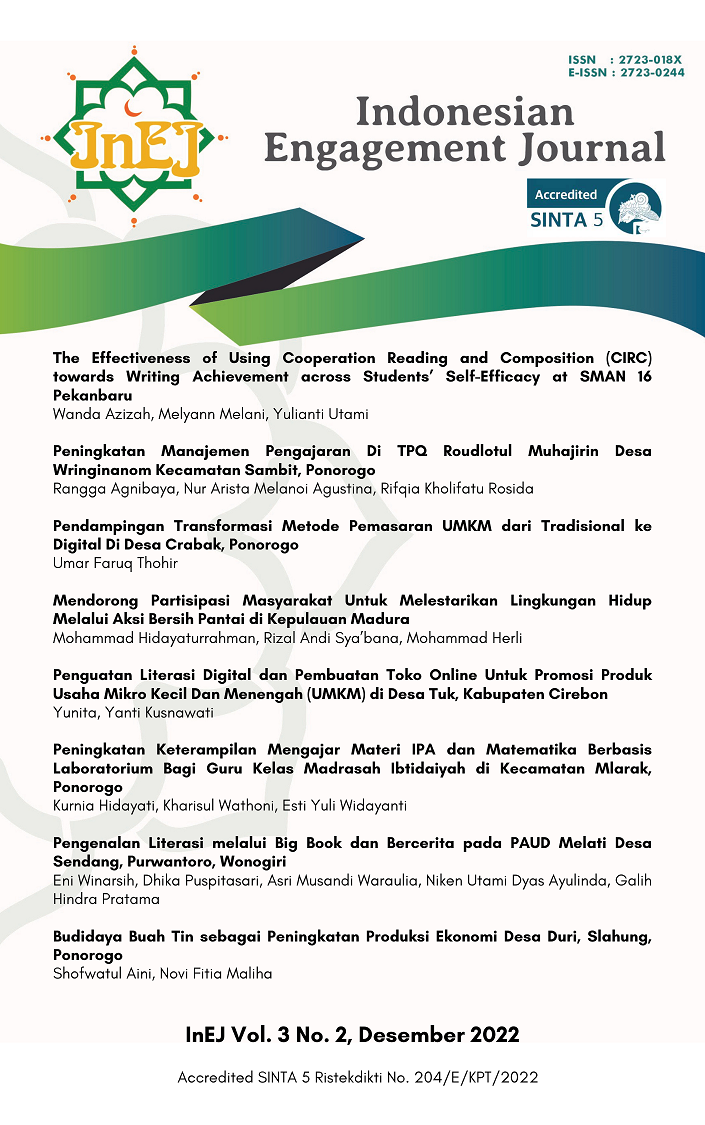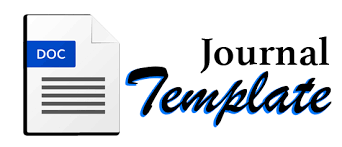THE EFFECTIVENESS OF USING COOPERATION READING AND COMPOSITION (CIRC) TOWARDS WRITING ACHIEVEMENT ACROSS STUDENTS’ SELF-EFFICACY AT SMAN 16 PEKANBARU
DOI:
https://doi.org/10.21154/inej.v3i2.5319Keywords:
Self-Efficacy, Writing and Cooperation Reading and Composition (CIRC).Abstract
This study proves the Effectiveness of Using Cooperation Reading and Composition (CIRC) on Writing Achievement in All Students' Self-Efficacy. Researchers conducted this research at SMAN 16 Pekanbaru. The purpose of this research, the researcher wants to prove, is there any influence from CIRC in arousing students' self-efficacy in writing. Which is the population for this study namely eleventh grade students, and for the sample the students in class XI MIPA-1 and XI IPS-2. And for the sampling technique the researcher used a purposive method. The type of research that researchers use is quasi-experimental design. For this study, researchers will measure students' self-efficacy using the CIRC method in learning to write. And the results show that there is no effect of this method in increasing students' self-efficacy in learning to write.
References
Almelhi, A. M. (2014). Effects of teaching argumentative reading and writing by integration in an e-learning environment on literary development in EFL college students. International Journal of Humanities and Social Science, 4(5), 85”“102.
Bandura, A. (1977). Self-efficacy: Toward a unifying theory of behavioral change. Psychological Review, 84(2), 191”“215.
Cole, J. & Feng, J. (2015, April). Effective strategies for improving writing skills of elementary English language learners. Paper presented at the Chinese American Educational Research and Development Association Annual Conference. Chicago.
Mariana, E. (2020). The Use of Cooperative Integrated Reading and Composition (Circ) Technique on Students’ Reading Comprehension. Journal of English Language Studies Volume 1 Number 2.
Nurul, K. (2017). The Effectiveness of Cooperative Integrated Reading and Composition (Circ) To Improve Writing in Descriptive Texts. ELT FORUM 6 (1) (2017). http://journal.unnes.ac.id/sju/index.php/elt
Rahmawati, F. (2016). The effect of using CIRC (Cooperative Integrated Reading and Composition) strategy on students’ writing ability at SMPN 3 Tanggul Jember in the 2013/2014 academic year (Unpublished master’s thesis). Universitas Muhammadiyah Jember, Indonesia.
Setyawati H. (2019). Cooperative Integrated Reading and Composition (CIRC) on Writing Achievement across Self-Efficacy. Volume 7, Number 2, June 2019, pp. 46”“52
Tanyer, S. (2015). The role of writing and reading self-efficacy in first-year preservice EFL teachers’ writing performance. Procedia-Social and Behavioral Sciences, 199, 38”“43.
https://ojs.stkippgri-lubuklinggau.ac.id/index.php/JPP/article/view/1305
https://onesearch.id/Record/IOS969.article-122?widget=1&institution_id=129
Downloads
Published
Issue
Section
License
Please find the rights and licenses in InEJ. By submitting the article/manuscript of the article, the author(s) agree with this policy. No specific document sign-off is required.1. License
The non-commercial use of the article will be governed by the Creative Commons Attribution license as currently displayed on Creative Commons Attribution-NonCommercial-ShareAlike 4.0 International License.
2. Author(s)' Warranties
The author warrants that the article is original, written by stated author(s), has not been published before, contains no unlawful statements, does not infringe the rights of others, is subject to copyright that is vested exclusively in the author and free of any third party rights, and that any necessary written permissions to quote from other sources have been obtained by the author(s).
3. User/Public Rights
The spirit of InEJ is to disseminate articles published are as free as possible. Under the Creative Commons license, InEJ permits users to copy, distribute, display, and perform the work for non-commercial purposes only. Users will also need to attribute authors and InEJ on distributing works in the journal and other media of publications. Unless otherwise stated, the authors are public entities as soon as their articles got published.
4. Rights of Authors
Authors retain all their rights to the published works, such as (but not limited to) the following rights;
Copyright and other proprietary rights relating to the article, such as patent rights,
The right to use the substance of the article in own future works, including lectures and books,
The right to reproduce the article for own purposes,
The right to self-archive the article,
The right to enter into separate, additional contractual arrangements for the non-exclusive distribution of the article's published version (e.g., post it to an institutional repository or publish it in a book), with an acknowledgment of its initial publication in this journal (InEJ: Indonesian Engagement Journal).
5. Co-Authorship
If the article was jointly prepared by more than one author, any authors submitting the manuscript warrants that he/she has been authorized by all co-authors to be agreed on this copyright and license notice (agreement) on their behalf, and agrees to inform his/her co-authors of the terms of this policy. InEJ will not be held liable for anything that may arise due to the author(s) internal dispute. InEJ will only communicate with the corresponding author.
6. Royalties
Being an open accessed journal and disseminating articles for free under the Creative Commons license term mentioned, author(s) aware that InEJ entitles the author(s) to no royalties or other fees.
7. Miscellaneous
InEJ will publish the article (or have it published) in the journal if the article’s editorial process is successfully completed. The editors of Journal may modify the article to a style of punctuation, spelling, capitalization, referencing and usage that deems appropriate. The author acknowledges that the article may be published so that it will be publicly accessible and such access will be free of charge for the readers as mentioned in point 3.




